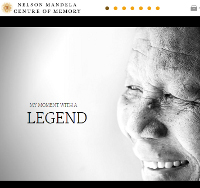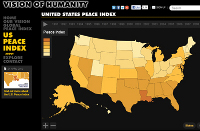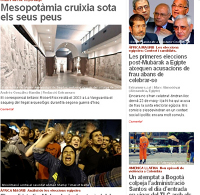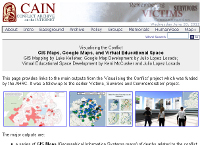Recommendations
More Recommendations
-

Nelson Mandela Digital Archive: bringing his legacy to the masses
http://archives.nelsonmandela.org/#!home
At the end of March 2012 an extensive digital archive on Mandela was launched, making available almost 2.000 entries about the first South African president to be elected in a fully representative democratic election.
Many of the documents, which are stored in the Nelson Mandela Foundation Centre of Memory in Johannesburg, have never been accessible or digitalised before. They include, amongst others, images of the cell on Robben Island, in which he spent many of his 27 years in jail, smuggled letters, posters, unpublished autobiographical manuscripts, photos, videos, and thousands of handwritten documents. Content is accessible free of charge anywhere in the world and available in English, Afrikaans and Xhosa. They have even thought about those who cannot decipher Mandela's handwriting, there is also a text version available.
The project, which makes it possible to "scroll" through the life of the man who received the 1993 Nobel Peace Prize, as well as over 250 awards, for his struggle against apartheid and his deep commitment to defending human rights, also aims to target poor, rural communities. Key in this respect is that the centre runs outreach programmes to help communities that may not have internet connections, so that they can also experience the archive.
The $1.25m costs of the project have been donated by Google, which also sponsors a similar project on Archbishop Desmond Tutu and the Holocaust archive (partnered with the Vad Yashem centre). It might come to mind that Google, whose slogan is "don't be evil" but which is often criticised for censorship and turning a blind eye to human rights abuses in countries like China, might be doing this to improve their image, but they are interesting projects nonetheless.
L.v.T.
-

US Peace Index
http://www.visionofhumanity.org/uspeaceindex/
On 24 April the second annual edition of the United States Peace Index was launched by the Institute for Economics and Peace, a non-profit research organization "dedicated to shifting the world's focus to peace as a positive, achievable, and tangible measure of human well-being and progress".
This 2012 US Peace Index highlights the US's most and least "peaceful states and cities". More precisely, the index examines levels of "peacefulness" at the state and city levels, while also looking at the costs associated with violence and the socio-economic measures associated with peace. In fact, it claims to be the only fullfledged statistical analysis of crime and the cost of crime in the US, looking into 50 states and 61 cities.
On the website of the US Peace Index, which also offers an interactive map and an explanatory video, we find that "peacefulness" is defined according to five indicators: the number of homicides, number of violent crimes, the incarceration rate, number of police employees, and the availability of small arms.
Important conclusions of the index include that the US is currently more peaceful than at any other moment in the past 20 years and that further improvements in peacefulness would generate hundreds of billions of extra economic activity. Hence, the index provides us with both some good news and an interesting suggestion, one which could be particularly appealing in times of economic crisis. Based on the data provided one could argue that, rather than cutting heavily on peace related activities, governments should actually seek further improvements in peacefulness. In fact, it is particularly right now, in times of economic crisis, that the relationship between poverty and peace deserves special attention.
L.v.T.
-

Extramurs: a new website about the world today in Catalan
Production routines of conventional media (newspapers, radio and television) all too often force journalists to cover international current affairs using major international news agencies, which are generally based on official, poorly verified sources.
The world news website in Catalan Extramurs was created in order to break out of this dynamic and flee from the 'monolithic' vision of these agencies. It is presented as a window to the world to speak up about what is happening around the globe, without filters, and with a network of professionals solely utilising local sources: not only local media, but also communities and associations and the potential of social networks. With the ever so commendable commitment to provide ethical and honest coverage based on in-depth analysis, interpretation, context, pluralism and knowledge of the political and social reality on the terrain.
The project currently has seven journalists at the news desk in Barcelona and collaborators in 20 countries –most Catalan journalists residing abroad–, and the goal is to continue to grow little by little.
We therefore welcome an ambitious project that is much needed in journalism today.
E.R.
-

Visualising the Conflict: CAIN goes Second life
http://maps.secondlife.com/secondlife/Ulster INCORE/116/128/21
Since the beginning of this year the Conflict Archive on the Internet (CAIN), an institution devoted to the collection of material on the "troubles" and located at the University of Ulster, is using a new way to approach the conflict that shook Northern Ireland for over thirty years: they have created a virtual island in Second Life, a 3D virtual world where people can socialize and connect.
On the island, called Ulster Inco, you will find virtual recreations of the peace wall, murals and other types of memorials of the conflict in Northern Ireland. Information panels provide users with background information and it is possible to attend classes and interact with other users.
This new way of approaching a topic as sensitive as the conflict in Northern Ireland should be welcomed and it will be exciting to see how succesful using Web 2.0, a type of website which promotes socialization through the creation of interactive virtual platforms, is for the dissemination of information on conflicts. CAIN's researchers will therefore collect data to evaluate the impact of this initiative. One thing is clear: it certainly makes learning about the conflict more interactive and entertaining.
Take a look for yourself at the virtual educational space developed in Second Life and interact with 3D models of the rapidly disappearing murals of Belfast. If you have Second Life viewer installed on your computer, and have a pre-existing avatar, you can click on the link above and visit the Visualising the Conflict virtual educational space. If you are currently not a user of Second Life you first have to download the programme/viewer and sign-up for an account and avatar. For those who are interested in knowing more about how to develop a virtual educational space, CAIN has made available guides that aim to pass on lessons learned, in order to help others trying to achieve similar projects.
L.v.T & L.M.